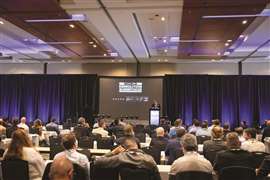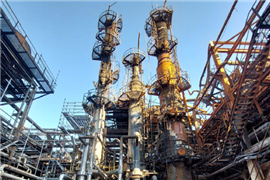How DH Griffin demolished a 100-year-old textile plant
05 January 2024
From 2021 to 2022 the D.H. Griffin (DHG) family of companies, including DARI, Infrastructure, Environmental & Wrecking, carried out the demolition of a 100-year-old, seven-storey textile plant situated near the Dan River in Danville, Virginia, US.
Known as the Dan River Mills Site project, in this article DHG reveals the unique challenges presented by the project and how it overcame them.
 DH Griffin’s high reach excavator on the Dan River Mills Site project. (PHOTO: DH Griffin)
DH Griffin’s high reach excavator on the Dan River Mills Site project. (PHOTO: DH Griffin)
“The project site was on a 46-acre plot by the Dan River and had been the site of manufacturing activities for much of the last century,” the team at DHG tells D&Ri.
“The main concern associated with the project was how to safely and efficiently demolish the 7-story finishing plant structure.
“Built in 1922 with additions added in 1952 and 1960, the structure was sturdily built to house heavy textile machinery.
“On the site there were also several remaining concrete footprints that posed a problem while we were planning out how to tackle the main building demolition.
Choosing the right demolition equipment
“When we first approached the project, we were contemplating using several machines like excavators and even a wrecking ball.”
DHG adds that because of the site’s close proximity to residential structures, as well as the structural aspects of the building, implosive demolition was quickly ruled out.
The contractors says: “When evaluating whether a high-reach excavator should be utilized, one must evaluate spatial requirements and other constraints.
“A few things to consider come to mind: clearance area, adjacent structures, height of structure, and permitted demolition means.
While high reach machines can prove expensive if there are delays to a project’s timescale, “after careful tests, consideration, preparation, and trial and error, we decided that high reach equipment would be the best bet for us to use on this job”, as it “allows operators to reach up and bring debris down effectively and in a controlled manner”.
As for the impact high reach machines can have on a project’s budget, DHG says that depends on the project’s demands.
“High reach machines are usually compared with implosions as an option for demolition projects. When you compare the two, the use of high reach machines will look more expensive in the offset, but when you consider the time, preparation, and labour that goes into demolition it starts to even out.
Of course “in the long run, cost efficiency will depend on how you run your project and the choices you make to keep your crew running as effectively as possible”.
Having chosen to use a high reach machine to carry out the main demolition tasks at the Dan River Mills Site, DHG then had to address another difficulty presented by the site.
Demolishing site challenges
“Secondary concerns were the deep concrete footings across the site,” it says.
“As built drawings did not capture the extent of the concrete placed in the ground at the time the former structures were constructed. Some excavations were in excess of 25 feet to remove the large footings.
“Not only was there a large amount of concrete on this job, the concrete was sturdily built, and we were working off of older drawings that didn’t have the entirety of the structures documented.
“A lot of the other buildings that were there before had left a footprint that we were surprised by.
“To fix the problem, we had to go methodically and dig up the concrete that was in the ground to make sure the high reach equipment could have sturdy ground to operate on.”
Concrete equipment solutions
DHG explains: “We utilized various excavators with thumb and buckets or different processors, mobile concrete crushers, skid steers and several other pieces from our 1000+ piece fleet to make sure our operation was moving as efficiently as possible.”
With several different types of machines at work, “the main safety risk of injury onsite was a struck by risk due to the number of heavy equipment and trucks operating at any given time”.
The company says: “While the high reach equipment was utilised to systematically demolish the building, our other equipment was used to size and stage materials before being loaded for additional processing or disposal.”
Demolition site health and safety
While a secondary risk was that of the deep excavations needed to remove the excessive footings, a third hazard came in the form of silica dust generated during the concrete demolition, loading and crushing operations.
“Working in enclosed cabs, utilizing equipment with built in water spray nozzles and utilization of additional water sources were all utilized to assist in dust control,” DHG says.
Additionally, “with jobs that require high reach equipment, the exposure to dust is longer than with a traditional implosion. Implosions are a one-time event that cause one large cloud of dust, while with high reach equipment the exposure to dust and debris is longer, for the duration of the job.”
As with all its projects, ensuring the safety of its team was the company’s priority. And on the Dan River Mills Site, and any projects that involve specialist equipment, a key aspect of this is the proficiency of its machine operators.
“In the United States, there isn’t a mandate for excavator training like there is for equipment like cranes,” DHG tells D&Ri. “With that being said, we at DH Griffin do not put operators into high reach equipment without proper experience in a regular excavator.
“They must be an expert with the regular machine before they are even considered to operate high reach machines because they are more sensitive to operate.
“DHG management will assess the operational skills of an operator and deem them competent on the equipment. Thus, DHG utilises only our most seasoned equipment operators for our high reach equipment.”
This safety-first approach has led DHG to become a leader in its field, with projects such as the Dan River Mills Site serving as evidence of both its safe working practices and expertise.
The contractor completed demolition works to the former textile plant, which included selective dismantling tasks to retain the building’s historical elements, such as an original smokestack that was to be incorporated in the construction of a new US$450 million casino on the site, in January of 2023.
CONNECT WITH THE TEAM









